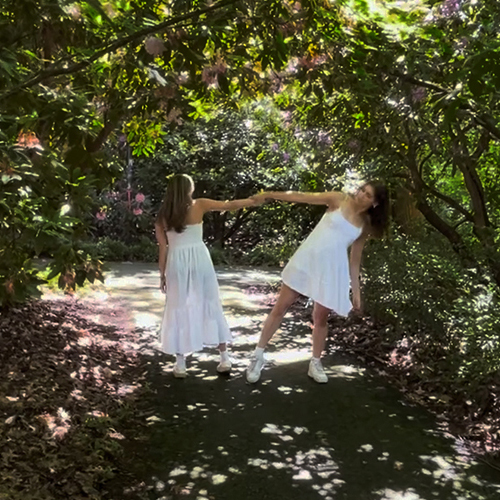Salsa dancing is a booming business. Salsa dance schools can be found as far away as Japan, and nightclubs devoted to salsa are packed. But as recently as the 1980s, salsa was relatively unknown outside the Latino community. Juliet McMains, assistant professor of dance, has been researching the rise in salsa’s popularity and its transformation over time.
“Salsa used to be a dance people in Latin America learned from their parents and community,” says McMains. “There was no formal dance instruction. You learned it from your mother in the kitchen. As a result, dance styles were always very regional. People listening to a piece of music in different communities came up with very different ways of moving.”

Salsa dance developed in response to salsa music. The music combines African American jazz with Caribbean genres; the dance combines African technique—isolated movements of the torso—with the European tradition of partner dancing. While salsa dancing is guided by a few basic rules, most notably six changes of weight to eight beats of music, much of it is improvisational.
How did this regional dance form enter the mainstream? One factor was a change in salsa music. Salsa songs had been songs of social protest with political lyrics, says McMains. Then, in the 1980s, romantic ballads became part of the salsa genre, making the music more accessible outside the Latino community. By the late 1980s and early 1990s, a much wider audience was interested in salsa music and, as a result, salsa dance.
With this interest came a problem: how does one learn a dance that had always been taught informally within Latino families and communities? “That’s when salsa schools emerged in significant numbers,” says McMains.
While non-Latinos flocked to the schools, Latinos in the U.S. also signed up for salsa lessons. That’s when things got really interesting.
“Puerto Ricans living in New York took lessons from Eddie Torres, a huge name in salsa,” says McMains. “Then they would return to Puerto Rico and convince Puerto Ricans that the way they’d been dancing salsa their whole lives was wrong and that this New York way was right. It was very ironic.”
The main difference between the homegrown style in Latin America and the academy style coming out of the U.S. was rhythmic consistency. Torres’s salsa had a rhythmic structure that had to be obeyed: the leader would always break forward on beat six and the follower would break back on beat six.
“Once you have this consistent rhythmic structure, it allows for much
more complex partnered steps and more improvisation,” explains McMains. “But even the idea of counting the music is really foreign to Latin Americans. A real division developed in Puerto Rico between academy (studio) salsa dancers and those who were not formally trained but had danced salsa their whole lives.”
Eventually Puerto Rico, and countries throughout Latin America, joined the trend and began opening dance schools of their own. But each region retained its individual flavor, as did U.S. cities with salsa schools. “I remember being at a nightclub in L.A. on a Saturday night, with 1,000 people dancing in a similar style of salsa,” says McMains. “It was a style unique to L.A. Each city had its own style.”
Never was that more obvious than at the first Salsa Congress in Puerto Rico in 1997. Elí Irizarry dreamed up the congress as a way to celebrate salsa, a source of cultural pride in Puerto Rico. Dancers from all over the world converged in San Juan for the event, which included workshops, social gatherings, and numerous opportunities to dance. Participants from far-flung locations soon discovered that while they shared a passion for salsa dancing, they had trouble dancing together because they were all doing something different. “It catapulted everyone into both trying to standardize salsa and also to borrow and steal and share,” says McMains. “People started to see that there were cool things they could learn from each other.”
The congress proved to be a turning point for salsa. Other congresses soon followed; up to 100 such events are now offered annually. With some dancers attending dozens of congresses in a year, the opportunities for cross-fertilization are astounding. “People are exchanging their movement vocabulary so quickly,” says McMains.
Some advocates are concerned that salsa’s increasing popularity and commercialization may dilute the dance form. In Puerto Rico, many salsa schools have closed—the public found the academy style and higher skill level to be snobby and inaccessible, says McMains. Yet salsa schools are still popular in other parts of Latin American and booming in many parts of the world. And, says McMains, there is still magic to be found at those salsa congresses.
“It’s an opportunity to meet someone from a country where you don’t speak a common language but you have this passion for salsa in common,” says McMains. “If you’re good dancers, you can have a conversation, through salsa, at a sophisticated level. There’s nothing like it.”
More Stories

A Statistician Weighs in on AI
Statistics professor Zaid Harchaoui, working at the intersection of statistics and computing, explores what AI models do well, where they fall short, and why.

The Mystery of Sugar — in Cellular Processes
Nick Riley's chemistry research aims to understand cellular processes involving sugars, which could one day lead to advances in treating a range of diseases.

Dancing Across Campus
For the dance course "Activating Space," students danced in public spaces across the University of Washington's Seattle campus this spring.